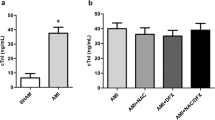Abstract
Cardiac surgery often generates oxidative stress leading to ischemia reperfusion injury (I-R). Antioxidants have been shown to prevent this injury and have been added to cardioplegic solutions to assist in recovery. In this study, we tested the effectiveness of sodium selenite in protecting against ischemia reperfusion injury and investigated the mechanisms behind this protection. Hearts from male Wistar rats were subjected to ischemia reperfusion using the Langendorf model. Krebs-Henseleit perfusion solutions were supplemented with 0,0.1, 0.5, 1.0, and 10μM sodium selenite. Hearts were perfused for 30 min and then subjected to 22.5 min of global ischemia followed by 45 min reperfusion. Heart rate, ischemic contracture, end diastolic pressure, and developed ventricular pressure were monitored. At the completion of the experiment, hearts were homogenized and tissue extracts were assayed for glutathione peroxidase (GSH-Px) and thioredoxin reductase (Thx-Red) activity. Sodium selenite, at a concentration of 0.5 μM, demonstrated a protective effect on the recovery of cardiac function following I-R, as evidenced by a lower end diastolic pressure and enhanced recovery of rate pressure product. There was no beneficial effect observed in hearts perfused with 0.1 μM sodium selenite-supplemented buffer, whereas poorer functional recovery was observed in hearts perfused with 10 μM sodium selenite-supplemented buffer. The beneficial effect of sodium selenite was not mediated through increased activity of GSH-Px or Thx-Red. This study demonstrates that the addition of sodium selenite to reperfusion solutions, at an optimal concentration of 0.5 μM, assists in cardiac recovery following ischemia reperfusion.
Similar content being viewed by others
References
R. Ferrari, G. Guardigli, D. Mele, G. F. Percoco, C. Ceconi, and S. Curello Oxidative stress during myocardial ischaemia and heart failure, Curr. Pharm. Des. 10, 1699–1711 (2004).
V. Sinci, S. Gunaydin, S. Kalaycioglu, H. Soncul, L. Gokgoz, and E. Oz, Effects of selenium enriched reperfusion solutions on isolated guinea pig hearts, Kelo J. Med. 47, 219–222 (1998).
H. Soncul, M. Kaptanoglu, E. Oz, et al., The role of selenium added to pulmonary preservation solutions in isolated guinea pig lungs, J. Thorac. Cardiovasc. Surg. 108, 922–7927 (1994).
K. Venardos, G. Harrison, J. Headrick, and A. Perkins, Auranofin increases apoptosis and ischaemia-reperfusion injury in the rat isolated heart, Clin. Exp. Pharmacol. Physiol. 31, 289–294 (2004).
P. Bauer, F. Belleville-Nabet, F. Watelet, F. Dubois, and A. Larcan, Selenium, oxygenderived free radicals, and ischaemia-reperfusion injury. An experimental study in the rat, Biol. Trace Element Res. 47, 157–163 (1995).
C. Ozturk, D. Avlan, I. Cinel, et al, Setenium pretreatment prevents bacterial translocation in rat intestinal ischaemia/reperfusion model, Pharmacol. Res. 46, 171–175 (2002).
R. Poltronieri, A. Cevese, and A. Sbarbati, Protective effect of selenium in cardiac ischaemia and reperfusion, Cardioscience 3, 155–160 (1992).
S. Tanguy, F. Boucher, S. Besse, V. Ducros, A. Favier, and J. de Leiris Trace elements and cardioprotection: increasing endogenous glutathione peroxidase activity by oral selenium supplementation in rats limits reperfusion-induced arrhythmias, J. Trace Elements Med. Biol. 12, 28–38 (1998).
S. Tanguy, M. C. Toufektsian, S. Besse, V. Ducros, J. De Leiris, and F. Boucher, Dietary selenium intake affects cardiac susceptibility to ischaemia/reperfusion in male senescent rats. Age Ageing, 32, 273–278 (2003).
M. C. Toufektsian, F. Boucher, S. Pucheu, et al., Effects of selenium deficiency on the response of cardiac tissue to ischaemia and reperfusion, Toxicology 148, 125–132 (2000).
K. Ytrehus, J. Ringstad, R. Myklebust, G. Norheim, and O. D. Mjos, The selenium-deficient rat heart with special reference to tolerance against enzymatically generated oxygen radicals, Scand. J. Clin. Lab. Invest. 48, 289–295 (1988).
M. Baines and A. Shenkin, Use of antioxidants in surgery: a measure to reduce postoperative complications, Curr. Opin. Clin. Nutr. Metab. Care 5, 665–670 (2002).
V. Treska, V. Kuntscher, D. Hasman, et al.., Importance of selenium for the influence of ischaemia-reperfusion syndrome after kidney transplantation from a non-heart beating donor in a pig model, Transplant, Proc. 34, 3057–3059 (2002.
V. Treska, V. Kuntscher, J. Molacek, J. Kobr, J. Racek, and L. Trefil, Can the ischaemia-reperfusion syndrome in transplanted kidneys procured from non-heart-beating donors be influenced by adding selenium into the reperfusion solution? An experimental study, Transplant. Proc. 35, 1584–1586 (2003).
L. Flohe, and W. A. Gunzler, Assays of glutathione peroxidase, Methods Enzymol. 105, 114–121 (1984).
E. S. Arner, L. Zhong, and A. Holmgren, Treparation and assay of mammalian thioredoxin and thioredoxin reductase, Methods Enzymol. 300, 226–239 (1999).
D. Erbas, H. Soncul, N. Turkozkan, A. Arioioglu, S. Muftuoglu, and A. Ersoz, Effect of selenium on ischemic and reperfusion injury in isolated guinea pig lungs, Gen. Pharmacol. Vasc. Syst. 26, 1669–1672. (1995).
K. Venardos, G. Harrison, J. Headrick, & A. Perkins, Effects of dietary selenium on glutathione peroxidase and thioredoxin reductase activity and recovery from cardiac ischaemia-reperfusion, J. Trace Elements Med. Biol. 18, 81–88 (2004).
S. Tanguy, S. Besse, V. Ducros, J. de Leiris, and F. Boucher, Effect of increased dietary selenium intake on blood and cardiac selenium status during aging in rats, Nutr. Res. 23, 239–243 (2003).
K. Venardos, G. Harrison, J. Headrick, and A. Perkins, Selenium supplementation and ischaemia-reperfusion injury in rats, Redox Rep. 9, 317–320 (2004).
Y. Chiba, R. Muraoka, A. Ihaya, H. Noguchi, T. Kimura, and K. Morioka, The significance of glutathione peroxidase on myocardial protection in the rat hearts: the key of clarify the cause of vulnerability to reperfusion injury in infantile, cardiac operations, Nippon Geka Hokan 63(4), 139–147 (1994).
Author information
Authors and Affiliations
Rights and permissions
About this article
Cite this article
Lymbury, R., Venardos, K. & Perkins, A.V. Effect of sodium selenite-enriched reperfusion solutions on rat cardiac ischemia reperfusion injury. Biol Trace Elem Res 114, 197–206 (2006). https://doi.org/10.1385/BTER:114:1:197
Received:
Revised:
Accepted:
Issue Date:
DOI: https://doi.org/10.1385/BTER:114:1:197




